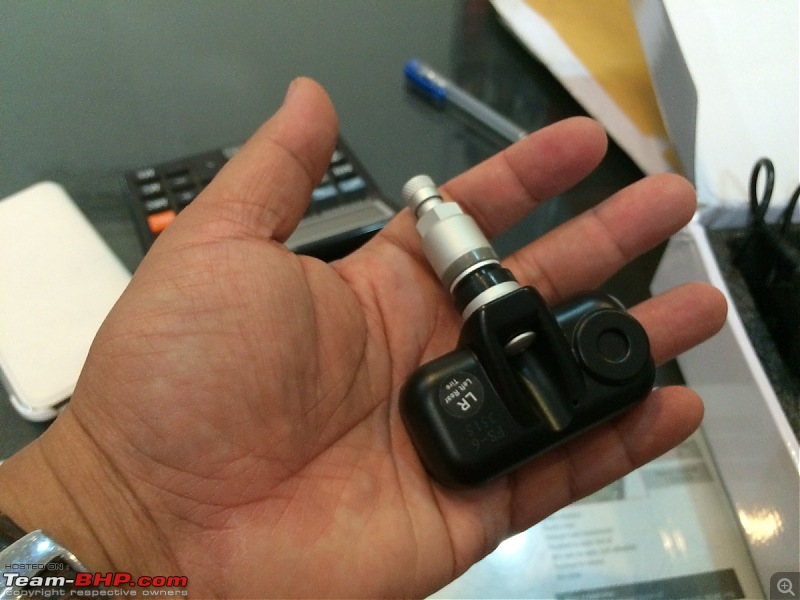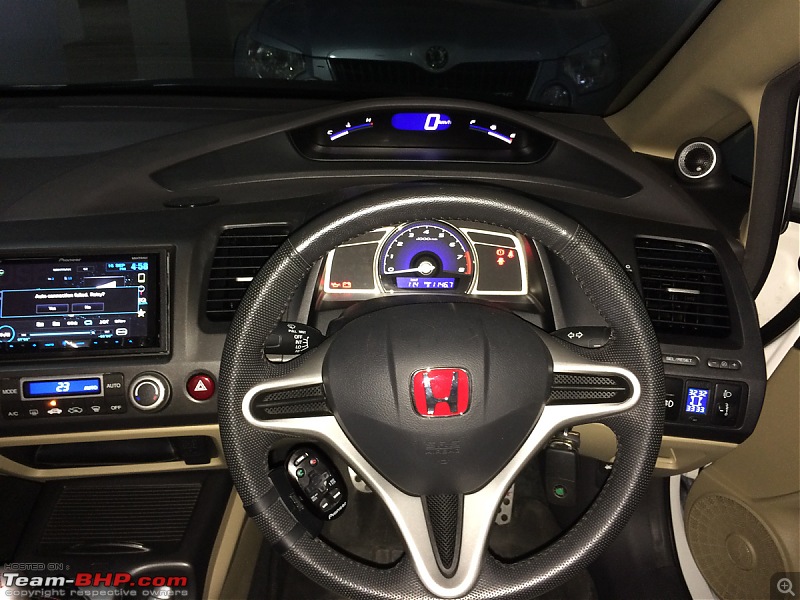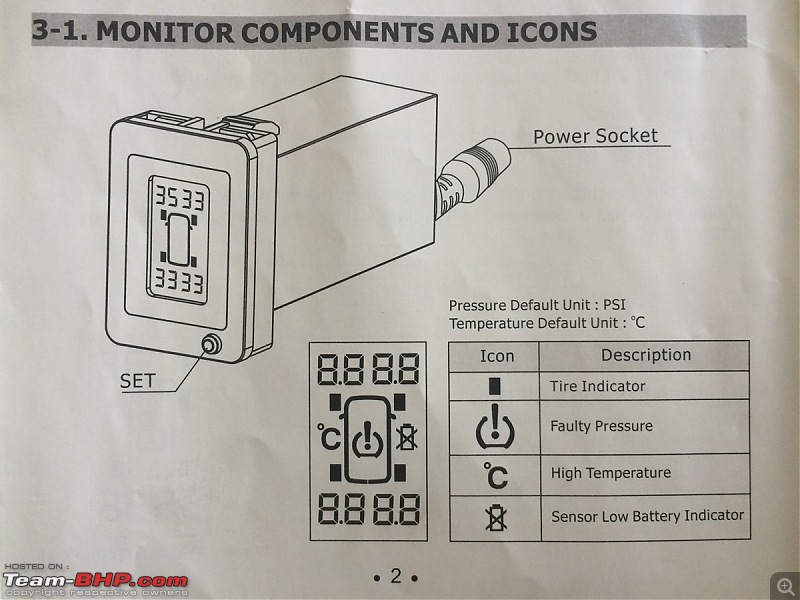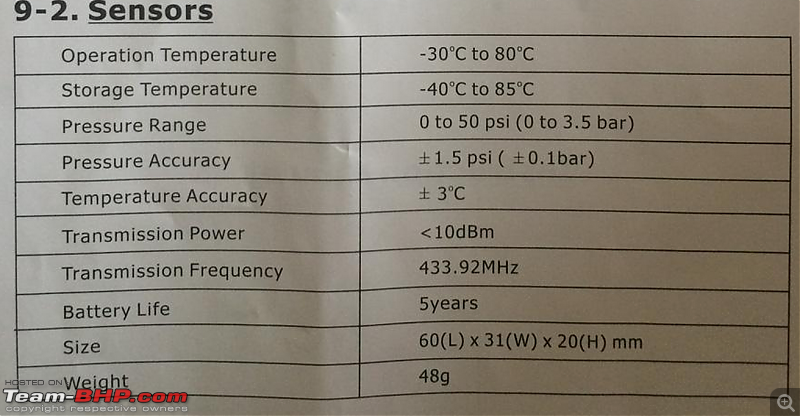Team-BHP
(
https://www.team-bhp.com/forum/)
One great investment I believe one can do on his/her car is to purchase a TPMS system. It is affordable, and can be sourced easily from your car accessories store or ebay, aliexpress etc. It gives you a sense of security (especially when you are on long trips), and relaxed driving knowing yours tyres are in good condition at the allowable air pressure.
I did get a Blaupunkt TPMS with external sensors for my other car (skoda yeti) and its been one of the gadget I had come to rely on every journey/trips. Additionally, I also enabled the TPMS based on ABS sensors on all 4 wheels through VCDS. The only limitation is that, once it detects a pressure lost, the TPMS gauge in the Maxidot needs to be erased/reset using VCDS.
For my Civic though, I wanted a TPMS that have an OEM look and feel, with internal sensors. My search leads to this from ebay.com -
http://www.ebay.com/itm/201384095670...%3AMEBIDX%3AIT Specification: - Embedded monitor,specified for: Honda CR-V, Crosstour, Odyssey, CIVIC, City, FIT, Elysion
- Reliable and easy to install
- Blue backlight
- Fixed high/low pressure/temperature warnings
- Two pressure unit(psi bar) supply for user to select!
- Displays pressure or temperature of 4 tires simultaneously
- Inter valve sensors,adjustable sensor mounting angle,water resistant
- Sensors batteries will last up to five years
- Sensors transmit pressure and temperature data every 5 minutes
- Individually coded sensors
Package included:
- Monitor*1
- Sensor*4
- Power cube*1
- User manual(English)*1
Inside the box, the display unit, and the 4 internal sensors, each marked with the location to go.

Ordered a week back with expedited shipping (from Hong Kong) and got it in within 4 days without any custom duty charge. Total cost = 10K INR (approx)
I choose this particular TPMS because of the display module fits perfectly on one of the empty switch slot (driver side). And even the background display takes the blue background color of the Civic console/speedo/odo/AC display and even the DVD player (pioneer). Moreover, there is no tangling wires to the cigarette socket. In short, it gives you an OEM look and feel.

A close look at the the internal sensor. Build quality is surprising good.

A close look at the monitor display unit. Notice, the 'TPMS' emboss and the SET button for programming.

And this is how it looks when installed on the empty switch slot. Neat one, looks a good OEM

Notice the blue backlight of the TPMS monitor matching the rest of the blue backlight of the Civic's odo, speedo, AC display and even the DVD unit.

The outer valve with sensor inside.

One word - Beautiful. Beautiful integration with OEM look. Alas, I cant mess with SKODA electronics, not with a DSG.
I too badly want a TPMS, but I am too afraid to do anything.
Looks really good. Why almost? It really looks OE. Can you please explain the TPMS features. What does that set button do? Also, when you rotate tyres, do you have to relocate the sensors as well?
Quote:
Originally Posted by PatchyBoy
(Post 3803914)
Looks really good. Why almost? It really looks OE. Can you please explain the TPMS features. What does that set button do? Also, when you rotate tyres, do you have to relocate the sensors as well?
|
The SET button allows you to choose and configure the TPMS display, choosing between PSI or Bar, temperature, or recoding of sensors after tyres rotation etc. You don't need to relocate the sensors at all. The system allows to re-code the sensors according to its actual position after rotation. The trick is to go into re-code mode and then inflate the tyre. That would force the sensor to send its ID code to the monitor.
I have attached screenshots to the manual.







How heavy is the internal sensor? Will this affect the balance of the wheels?
Quote:
Originally Posted by poloman
(Post 3804008)
How heavy is the internal sensor? Will this affect the balance of the wheels?
|
Each sensor weighs 48 grams. You will need to re-balance your wheel after the sensor install. I didn't remember the exact weights on each wheels, but in total I was charge for 280 grams for all 4 wheels. I made numerous runs on the expressway and city, no wobbling or shaking in higher speed.
Very nice. How long will the battery in the sensor last. Replacing a battery means popping the tyre off, replacing the battery, and rebalancing the wheel I guess?
Jeroen
Quote:
Originally Posted by Jeroen
(Post 3804096)
Very nice. How long will the battery in the sensor last. Replacing a battery means popping the tyre off, replacing the battery, and rebalancing the wheel I guess?
Jeroen
|
5 years as per the manual

Quote:
Originally Posted by Jeroen
(Post 3804096)
Very nice. How long will the battery in the sensor last. Replacing a battery means popping the tyre off, replacing the battery, and rebalancing the wheel I guess?
Jeroen
|
Most internal sensors don't have provision to replace the batteries because the harsh condition inside the tyre (high temperature, or high RPM) requires that the sensor be in single sealed piece with reinforced walls to withstand it. And that is why, the battery part in such sensor is larger and hold higher capacity to last 5-7 years easily. Anyway, 5 years is a good life span for any accessory.
As I have both external and internal sensors on two of my cars, I can sum up the following on usability:
1. The battery on the internal sensor is not replaceable, but will last longer as it has higher capacity. The battery on the external sensor though smaller, is replaceable.
2. Internal sensors provide a more accurate readings of the pressure/temperature than external ones as being internal, the outside factor (sunlight, winds, snow etc) does not put an error margin. On the other hand, the error margin goes higher with external sensors because of its exposure to sunlight, heat and other environmental factors.
3. The susceptibility of the external sensors to being stolen, knocked off is high and may not last for the entire product life. One needs to factor in the hidden cost of additional sensors.
4. With external sensors, you will have to remove the cap with the special Allen wrench key that came with the product, every time you need to inflate or deflat the tyres. And I am telling you, its time taking and cumbersome. And if you happen to misplace that small little special Allen wrench, you are in a whole lot of inconvenience. And yes, with external sensors, you will not most likely use the bunk's air pressure to top up. You will need to invest in your own portable air pressure system.
5. On the convenient side, external sensors can be easily mounted and use with multiple alloys/vehicles. And they are usually cheaper than internal ones. Moreover, there is no requirement to balance the wheels.
Thanks for the write up. Very useful.
Does it need any periodic calibration?
Interesting thread. Manufacturers these days are doing away with Sensor based TPMS systems. In general, there have been too many complaints about sensors not being able to live up to the rigors of the road and throwing faulty readings or TPMS errors. e.g. My 2015 Honda CRV does not have a TPMS sensor any more. The system requires me to fill the tires with the right air pressure and then hit a calibrate switch. The car then monitors the speed sensors on each wheel and some other factors to establish a 'baseline' for tries filled to the right pressure. The car constantly monitors those factors and if it finds a major deviation with the baseline value, then throws a TPMS alert.
The advantage with such a system is that it is way more reliable and less prone to hazards of the road or someone breaking the sensor when changing tires. But it does not give me a pressure reading for each tire. It just tells me if I am low on pressure. The other disadvantage with this system is that it needs to be calibrated each time I fill air. Although pressing a switch is not a big deal, its still something one has to do.
Quote:
Originally Posted by iTNerd
(Post 3804338)
Moreover, there is no requirement to balance the wheels.
|
I beg to differ as it is important to balance the wheels even if it is external type sensor.
I did balance my wheels with the external sensors bolted on and it took 15g per wheel.
Quote:
Originally Posted by torque!!
(Post 3804457)
Interesting thread. Manufacturers these days are doing away with Sensor based TPMS systems. In general, there have been too many complaints about sensors not being able to live up to the rigors of the road and throwing faulty readings or TPMS errors. e.g. My 2015 Honda CRV does not have a TPMS sensor any more. The system requires me to fill the tires with the right air pressure and then hit a calibrate switch. The car then monitors the speed sensors on each wheel and some other factors to establish a 'baseline' for tries filled to the right pressure. The car constantly monitors those factors and if it finds a major deviation with the baseline value, then throws a TPMS alert.
The advantage with such a system is that it is way more reliable and less prone to hazards of the road or someone breaking the sensor when changing tires. But it does not give me a pressure reading for each tire. It just tells me if I am low on pressure. The other disadvantage with this system is that it needs to be calibrated each time I fill air. Although pressing a switch is not a big deal, its still something one has to do.
|
The TPMS you are referring to is not the best, as it works on the speed sensors in the respective wheels. I have the system in my Passat. Last year I was in Bangalore and I drove over an open gutter; both the front right & rear right tyres lost pressure very quickly and became flat in a few seconds. I did not get any alert from the TPMS. Had to renew both tyres :Frustrati
In the US, it is now mandatory to have the TPMS that indicates the pressure for each tyre. This is the most reliable system.
Quote:
Originally Posted by torque!!
(Post 3804457)
Interesting thread. Manufacturers these days are doing away with Sensor based TPMS systems. In general, there have been too many complaints about sensors not being able to live up to the rigors of the road and throwing faulty readings or TPMS errors. e.g. My 2015 Honda CRV does not have a TPMS sensor any more. The system requires me to fill the tires with the right air pressure and then hit a calibrate switch. The car then monitors the speed sensors on each wheel and some other factors to establish a 'baseline' for tries filled to the right pressure. The car constantly monitors those factors and if it finds a major deviation with the baseline value, then throws a TPMS alert.
The advantage with such a system is that it is way more reliable and less prone to hazards of the road or someone breaking the sensor when changing tires. But it does not give me a pressure reading for each tire. It just tells me if I am low on pressure. The other disadvantage with this system is that it needs to be calibrated each time I fill air. Although pressing a switch is not a big deal, its still something one has to do.
|
What you had described is a passive or indirect TPMS type which is solely based on wheel sensors of the car ABS system. Such TPMS type is solely software driven with no requirements of additional hardware. However, it cannot measure/display absolute pressure values, cannot tell you which tyre has the problem and requires reset after pressure adjustment/exchange of tyres. Typically, this reset procedure involves driving the car for 20-40 mins or so to re-learn/re-train the system to take the new parameters. Most VAG cars comes with this passive/indirect TPMS systems in lower trim. Have this in my Skoda yeti, but I also wanted to have a real time reading of the pressure/temperature of all 4 tyres, so got added an active/direct TPMS which uses individual sensor component in each wheel either as a valve cap (external sensor) or mounted inside the rim (internal sensor). Most will prefer the active/direct TPMS because of the real time information you get.
What is the battery model for the wheel sensors and battery life of each ?
| All times are GMT +5.5. The time now is 11:05. | |
















